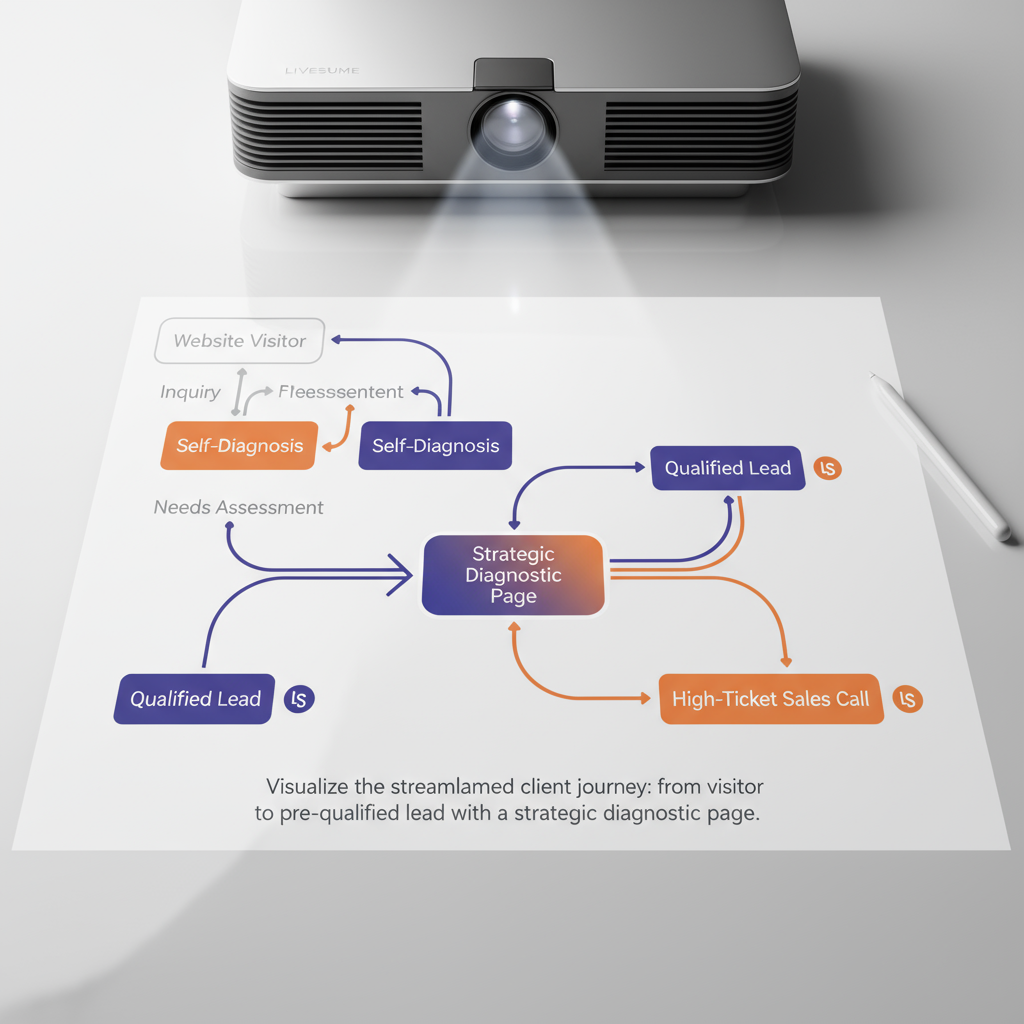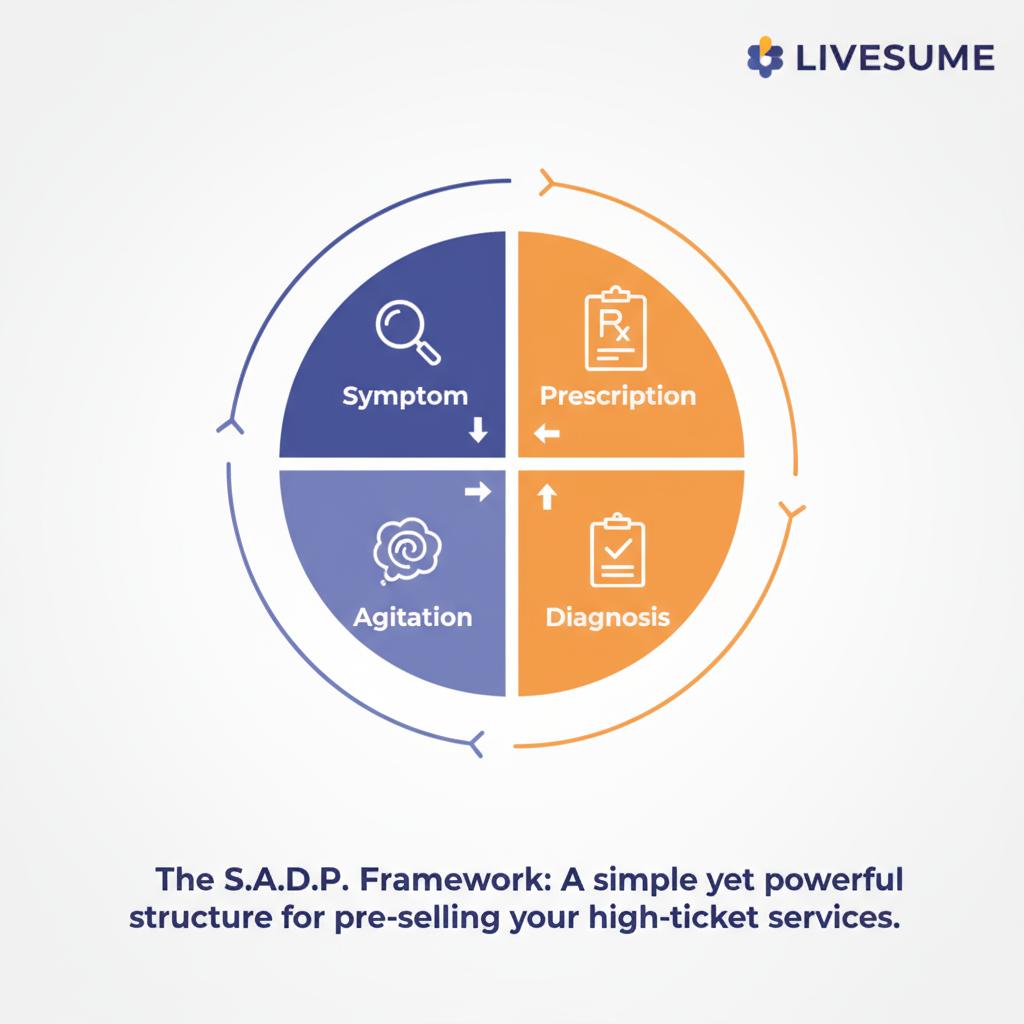Are you stuck in a cycle of writing long proposals for clients who ghost you? It's a massive time sink, and it often feels like you're just guessing what they really need. What if you could flip the script? Instead of you pitching them, they qualify themselves for you, showing up to a sales call already convinced you're the expert they need. That’s the power of a client diagnostic page, and you can build one in minutes.
Key Takeaways: Why a Diagnostic Page Works
Shifting your professional page from a passive portfolio into an active diagnostic tool is a strategic move. Here’s the immediate impact:
- Eliminate Unqualified Leads: Automatically filter out clients who aren't a good fit, saving you dozens of hours in wasted meetings.
- Justify Your Premium Rates: By diagnosing their problem upfront, you shift the conversation from cost to value, making your high-ticket price a no-brainer.
- Establish Instant Authority: A thoughtful diagnostic process proves you're a strategic partner, not just a service provider who takes orders.
- Shorten Your Sales Cycle: Clients arrive at the first call already understanding their problem and seeing you as the solution.

What Is a Client Diagnostic Page (And Why Does It Beat a Portfolio)?
Forget static portfolios that just show off past work. A client diagnostic page is an interactive experience designed to help potential clients self-identify their biggest challenges. It's not a complex quiz with conditional logic; it's a single, thoughtfully structured page that guides a visitor through a process of reflection and realization.
The goal is simple: by the time they finish reading, they have a crystal-clear understanding of their problem and see your service as the logical next step. It's a powerful shift in positioning.
Before: A potential client lands on your page, sees a gallery of your work, and thinks, "Nice work, but how does this apply to *my* specific problem?" They might reach out, or they might just click away.
After: A potential client works through your diagnostic page. They answer questions (in their own head) that pinpoint their exact pain points. They feel understood and see a clear path forward, presented by you. They don't just want to hire *a* freelancer; they want to hire *you*.
The S.A.D.P. Framework: Turn Your Page Into a Sales Tool
To build this, you don't need fancy quiz software. You just need a simple, powerful framework. We call it S.A.D.P.: Symptom, Agitation, Diagnosis, and Prescription. Here’s how to structure your Live Resume page to follow this flow.
1. Symptom: Identify the Obvious Pain
Start your page by describing the surface-level problems your ideal client is experiencing. These are the things that keep them up at night. Use the language they use. Are they frustrated with low website traffic? Overwhelmed by disorganized project management? Burning out from doing everything themselves? List these symptoms clearly using bullet points or short, punchy headlines.
2. Agitation: Dig Into the Root Cause
This is where you show your expertise. Connect the symptoms to the deeper, more painful problem. This is where you ask the tough questions that make them think. For example:
- "You're seeing low traffic (Symptom), but is the real issue a lack of a clear SEO strategy that speaks to high-value customers? (Agitation)"
- "Projects are chaotic (Symptom), but is it because your team lacks a single source of truth for key decisions? (Agitation)"
This section makes the client feel seen and understood on a deeper level. You're not just a hired hand; you're a strategist.

3. Diagnosis: Name the Problem and Frame the Solution
Now, give their problem a name. You are the expert, and this is your professional diagnosis. Frame it clearly and confidently. For example, "You're not suffering from 'bad marketing'; you're dealing with a 'Qualified Lead Deficit.'" or "This isn't just 'disorganization'; it's a 'System Scalability Gap.'"
Naming the problem makes it tangible and solvable. It also positions you as the authority who can fix it. This is a crucial step in building what we call the 'Human Stack'—your unique strategic value.
4. Prescription: Present Your Service as the Clear Next Step
Finally, present your high-ticket offer as the direct, logical cure for their diagnosis. This isn't a hard sell. It's helpful advice. Your prescription should clearly outline the outcome, not just the deliverables. Don't just list "5 blog posts"; describe "A content system that attracts and qualifies 10 new leads per month." This naturally leads them to your core services page or a booking link for a discovery call.
Stop Guessing. Start Diagnosing.
Ready to build a page that attracts the best clients? Use Livesume’s AI helpers to craft your diagnostic questions and frame your expert prescription. Turn your expertise into your best sales tool.
Build Your Diagnostic Page Now
How to Use AI to Build Your Diagnostic Questions Fast
Coming up with the right questions is the hardest part. But with the right AI tools, you can do it in minutes, not hours.
Step 1: Uncover Core Pains with Perplexity AI
Use a research-focused tool like Perplexity to understand the market's true pain points. Use a prompt like:
"Acting as a market research analyst for a freelance [Your Role, e.g., 'Web Developer'], analyze forum discussions on Reddit and industry blogs to identify the top 5 frustrations early-stage SaaS companies have with their MVP websites. Focus on business outcomes, not just technical issues."
This will give you the raw material for your "Symptom" section.
Step 2: Craft Nuanced Questions with Claude 3 Opus
Once you have the pain points, use a sophisticated model like Claude to turn them into insightful diagnostic questions. Use a prompt like:
"Based on the following client symptom: 'Our website doesn't generate leads.' Generate 5 'Agitation' questions that probe the deeper business problem. The questions should make the client reflect on strategy, positioning, and missed opportunities, not just technical SEO."
This helps you craft the "Agitation" section that demonstrates your strategic depth.
This AI-assisted approach ensures your diagnostic tool is rooted in real market needs, connecting your value directly to the strategy of value-based pricing.

Before AI: Spending hours trying to guess what questions to ask, resulting in a generic intake form.
After AI: Generating deeply insightful, market-validated questions in 15 minutes, creating a diagnostic that resonates powerfully with ideal clients and increases qualified lead flow by over 50%.
Frequently Asked Questions
How do I stop wasting time on bad freelance clients?
A client diagnostic page is your first line of defense. By making potential clients think through their own problems before they even contact you, you filter out those who are just price-shopping or aren't serious. Good clients appreciate the strategic approach; bad clients are deterred by it.
What is a client diagnostic session?
A diagnostic session is typically a paid discovery meeting where you dive deep into a client's business to create a strategic plan. A diagnostic page is the free, automated version of this. It gives them a taste of your strategic value upfront, making them more likely to pay for a full session or high-ticket project.
How can I pre-qualify consulting leads for free?
Use the S.A.D.P. framework on your Livesume professional page. The entire process costs you nothing beyond your time to set it up. It acts as a 24/7 automated qualification tool, ensuring that the leads who book a call with you are already pre-sold on your expertise.
What questions should I ask a potential client before a sales call?
Your diagnostic page should implicitly ask questions that reveal their strategic challenges. Focus on questions about business goals, missed opportunities, and the financial or operational impact of their problem. Avoid simple questions about budget or timeline; the page's goal is to make them *find* the budget for you.
Can I build a client quiz without using special software?
Absolutely. That's the point of this framework. You don't need a tool like Typeform. By structuring the text and headlines on a single Livesume page, you create a "mental quiz" that a client walks through. It's simpler to build and just as effective for pre-qualification.
How do I position myself as an expert, not just a freelancer?
Experts diagnose; freelancers take orders. Shifting from a portfolio (Here's what I did) to a diagnostic (Here's what you need) is the fastest way to change that perception. It proves you understand their industry and can provide strategic value beyond simple execution.
Turn Your Page Into a Client Magnet: Your Next Steps
You now have the framework to stop being a service provider and start being a sought-after expert. The best part? You can build this entire client-attraction engine today.
- Map Your Framework: Grab a notebook and outline your S.A.D.P. flow. What are the common symptoms of your clients? What's the real problem you solve?
- Generate Your Questions with AI: Use the prompts above with a tool like Claude or Perplexity to craft your core diagnostic questions.
- Build Your Page on Livesume: Sign up or log in to Livesume. Use the simple drag-and-drop builder to structure your page according to your framework. Use our AI Content Helper to refine the copy until it's perfect.
Stop pitching and start diagnosing. That's how you win better clients, command higher fees, and build a freelance business that respects your time and expertise.